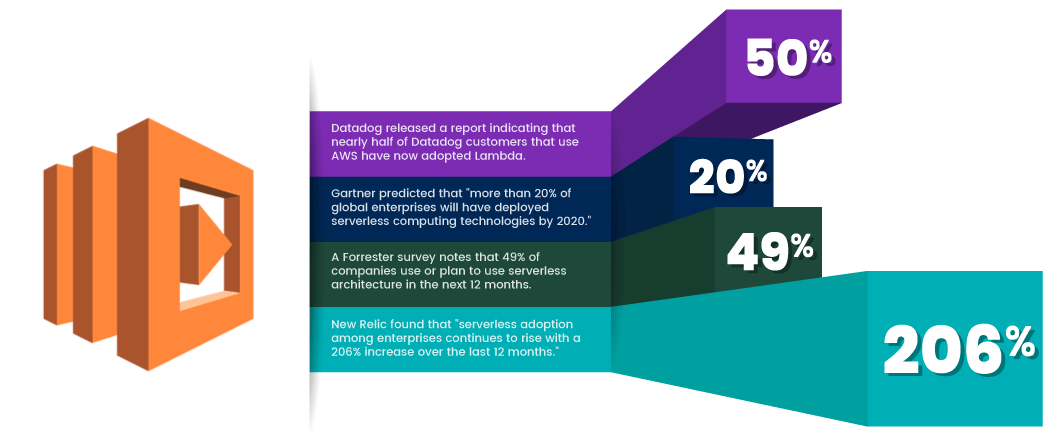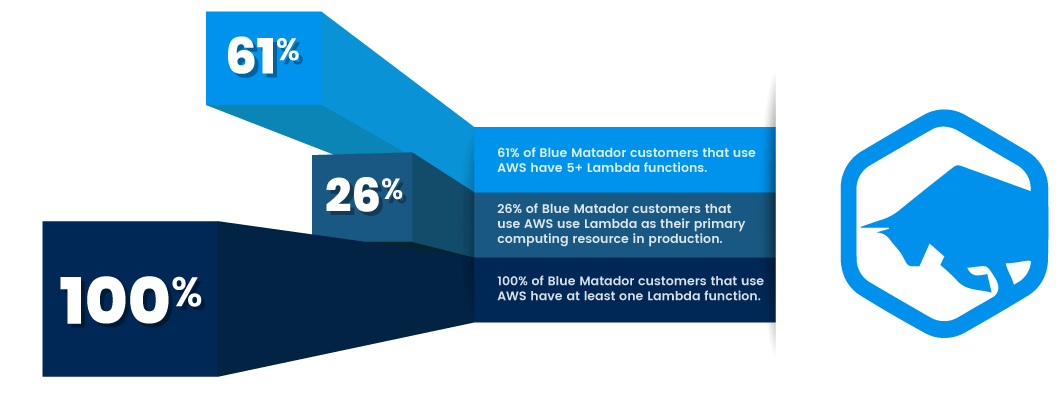It’s no secret that AWS Lambda adoption has grown steadily since AWS first released it in 2015—and for good reason. The benefits of adopting Lambda are many: leveraging Lambda eliminates the need to provision and manage servers, enabling teams to just focus on their code without the mental and operational overhead of worrying about the underlying infrastructure. And from a cost perspective, Lambda allows teams to optimize for cyclical, bursty workloads instead of having to manage and pay for an over-provisioned infrastructure designed to accommodate seasonal traffic loads year-round.
Several vendors and analysts have recently reported accelerated adoption of Lambda among AWS users, including among the Blue Matador user base. In this post, we’ll share what we are seeing with Lambda adoption among our user base relative to what other vendors and analysts are reporting.
Recent industry reports of serverless computing adoption

- In February, Datadog released a report indicating that nearly half of Datadog customers that use AWShave now adopted Lambda (their definition of "adopting" Lambda is having five distinct Lambda functions). This percentage has grown to nearly 50%, but in January 2018 it was just over 20%. So a very rapid increase over the last two years!
- In December 2018, Ross Winser, senior research director at Gartner, predicted that “more than 20 percent of global enterprises will have deployed serverless computing technologies by 2020, which is an increase from less than 5 percent today.” Gartner’s Arun Chandrasekaran, distinguished vice president and analyst, followed up to say that adoption is inching close to the 20% this year but might fall slightly below prior expectations. “The adoption rate could be between 10% and 20% at this time,” he said. So Gartner’s forecast is much lower than what Datadog is seeing, but this is not an apples-to-apples comparison—Gartner’s percentage takes into account enterprises that are still on-prem, using other clouds etc. That being the case, getting to 20% usage of ALL global enterprises for a technology that was released only 5 years ago is pretty impressive.
- In Forrester’s 2019 Global Business Technographics Developer Survey, it noted that 49% of companies are using or plan to use serverless architecture in the next 12 months. Another impressive indication of the permissiveness of Lambda usage and adoption.
- Lastly, New Relic recently published a report that found that “serverless adoption among enterprises continues to rise with a 206% increase in average weekly invocations over the last 12 months. The enterprises using serverless in production are expanding their serverless footprint with a 178% increase of functions per account.” This data would indicate that not only is the rate of Lambda adoption increasing, but those that are using Lambda are expanding their usage at nearly a 3x rate.
Lambda adoption among Blue Matador customers

We wanted to see how Lambda usage among Blue Matador users stacked up relative to the other reports and statistics mentioned above. This is what we found:
- 61% of Blue Matador customers that use AWS have 5 or more Lambda functions. Using Datadog’s definition of “Lambda adoption” (i.e. 5 or more Lambda functions), 61% of Blue Matador customers have adopted Lambda. We weren’t too surprised by this discrepancy. Small, fast-moving, innovative teams naturally gravitate to Blue Matador, and Datadog is likely serving more less-agile enterprises that don’t adopt new technologies as quickly.
- 26% of Blue Matador customers that use AWS use Lambda as their primary computing resource in production. Looking at our customers that are "all-in" on Lambda, 26% are using Lambda as their primary compute for their production workloads. So although a very high percentage of our customers have "adopted" Lambda, a relatively small number, 26%, have gone "all-in." But, anecdotally, we are seeing more and more examples of clients building new projects and workloads exclusively on Lambda, so we expect this percentage to continue to climb over time.
- 100% of Blue Matador customers that use AWS have at least one Lambda function. Perhaps the most surprising statistic is that all of our AWS clients have at least one Lambda in their account. This seems to be a good indicator that just about all organizations are dabbling in Lambda or thinking about serverless use cases for their organizations.
Conclusion
Considering Lambda is only 5 years old, it is very impressive to see the rate of adoption among our customer base and the supporting reports and statistics. And given the serverless-related questions we hear in product demos and interest we are seeing in our Lambda monitoring solution, we don’t foresee these trends stalling anytime soon.



